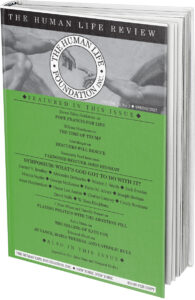Reflection on St. Francis of Assisi
The feast day of St. Francis of Assisi tomorrow (October 4) prompts us to consider what this most beloved of Christian saints has to contribute to how we think of the natural environment and our current concerns about it. His “Canticle of the Creatures,” a hymn of praise for all creation, conveys a vision of the way we are related to the world around us—sun and moon, wind and water, fire and “mother earth” with all her fruits, extending even to “our sister, bodily death”—a vision that tells against man’s urge to dominate and control. An English Franciscan, Fr. Eric Doyle, has written that St. Francis,
Though physically blind, . . . was able to see more clearly than ever with the inner eye of his mind. With unparalleled clarity he perceived the basic unity of all creation and his own place as a friar (brother) in the midst of God’s creatures. . . . He was so open to reality that it found a place to be at home in his heart and he was at home everywhere and anywhere. He was a center of communion with all creatures. (St. Francis and the Song of Brotherhood and Sisterhood. Franciscan Institute, 1966.)
Our current pope is the first one in history to choose the name of Francis, and his reason is expressed in the opening paragraphs of his 2015 encyclical Laudato si (the opening words of the “Canticle of Creatures”) in which, he writes,
Saint Francis of Assisi reminds us that our common home is like a sister with whom we share our life and a beautiful mother who opens her arms to embrace us. . . . [But] this sister now cries out to us because of the harm we have inflicted on her by our irresponsible use and abuse of the goods with which God has endowed her. We have come to see ourselves as her lords and masters, entitled to plunder her at will.
Pope Francis is posing a fundamental dichotomy between a dominating and a familial relation of ourselves to the world of nature that surrounds us (“brother sun, sister moon”). He is deploying the poetic vision of St. Francis to interpret the crises that engulf us due to man-made climate change.
However, St. Francis’s poetic vision of “the basic unity of all creation and (our) own place . . . in the midst of God’s creatures,” while inspiring, may be misleading if it is not considered in the light of the teaching of sacred scripture. There, in Psalm 8, we find man’s wonder at our place in relation to the other creatures:
You have made him but one step lower than the angels; you have crowned him with glory and honor; you have set him over the works of your hands.
Now, to be “set over” the other creatures does not necessarily mean to dominate and try to control them. In the second creation narrative of Genesis (2:4-25), the Lord God puts Adam “in the garden of Eden to till it and keep it” (rather than to dominate and try to control it), and brings every other living creature to Adam “to see what he would call them; and whatever the man called every living creature, that was its name.” (2:19)
The privilege of naming the other creatures indicates Adam’s superiority; and at the same time his relation to them, since the name of each creature signifies its distinct nature, one by which Adam could know it. This knowledge of his fellow creatures enables Adam to treat them intelligently—that is, not to abuse them. But because they don’t have his intelligence, Adam cannot find in them his equals—“sisters” or “brothers.” It is in this respect that the poetic vision of St. Francis can be misleading. Only in his equal—Eve, the person formed from his side, “bone of his bone, and flesh of his flesh”—can Adam find what he most needs, full and mutual communion.
The creation narrative of Genesis goes on, of course, to describe man’s fall from grace: Adam and Eve forfeit their union with their creator by violating the one restriction he had placed upon them, and this introduces a disharmony of man with his fellow creatures: the “ground” is now “cursed” for Adam; tending it will be “toil.” And the pains of child-bearing are “multiplied” for Eve. (3:16-19) The witness of sacred scripture—the inspired Word of God—and the teaching of the Church is that the peace that originally prevailed in man’s relation to his fellow creatures has been lost.
This loss—cosmic in scope and impossible to recover by mere human effort—prevents us from ever hoping to reverse the devastation wrought by man’s abuse of his environment. We must be prepared to suffer its consequences, and look to our divine creator to redeem the mess that we have made. But Jesus, in his cross and resurrection, has already accomplished this, and our faith in him offers us the hope not of “repairing” this old world, but of being presented with a whole new world, the “new heaven and a new earth” that John the Evangelist proclaims in the Book of Revelation, chapter 21.
Because St. Francis was a faithful Christian, his “Canticle of the Creatures” presupposes the redemption of the world by Jesus Christ: It is a song of love, born of the vision of faith and hope.









